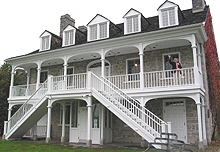 Aylmer -- now a part of the City of Gatineau -- has one of the most impressive concentrations of heritage buildings in Quebec. Many of them date from the first half of the 19th century. Many of them may be found within close proximity of one another in the old village centre.
Aylmer -- now a part of the City of Gatineau -- has one of the most impressive concentrations of heritage buildings in Quebec. Many of them date from the first half of the 19th century. Many of them may be found within close proximity of one another in the old village centre.
There are far too many heritage buildings in old Aylmer to include them all in a short article such as this. A few of them, however, certainly deserve mention, and will serve to whet one’s appetite for a more in-depth tour of the village.
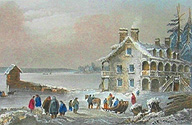
Without a doubt, Aylmer’s greatest historic treasure is the old Symmes Inn (2 Principale Street). Built in 1831, and overlooking the splendid Ottawa River, the Inn was built by Charles Symmes as a stopover on the stage and steamer route up the Ottawa River Valley. Built entirely of cut stone, the Inn was made famous by artist William Henry Bartlett, who included an engraving of the building in his book, Canadian Scenery Illustrated (1842).
Symmes, a nephew of Hull pioneer Philemon Wright, did extremely well for himself, becoming one of the wealthiest men in town. Today, his Inn is home to the local museum.
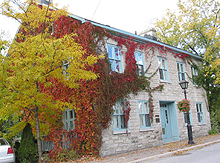
Not far from Symmes Inn is the Parker House (7 Front Street). Like Symmes Inn and many of Aylmer’s oldest buildings, this house is constructed entirely of locally quarried stone. About half of the house is covered in vines, which in autumn turn splendid shade of red. According to the Aylmer Heritage Association, “local legend” has it that Parker House is inhabited by a ghost. Another notable stone dwelling is Lakeview (61 Principale Street). Built by Irish immigrant Robert Conroy in 1855, this monumental house with its prominent neo-classical pediments reflects Conroy’s prominence as a successful merchant, timber dealer, and owner of the nearby British Hotel.
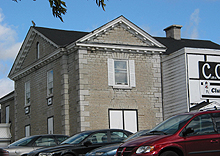
Lakeview, which takes its name from the fact that it once commanded an unbroken view of Lake Deschênes, is said to have been as beautiful inside as it once was outside. The mansion has deteriorated considerably since its heyday, and is now home to a club.

Across the street is the Conroy-Driscoll House (72 Principale Street). Built in 1845, this house is said to have been Conroy’s home before he built Lakeview in 1855. In later years, it was purchased by Alfred Driscoll, a land surveyor. Today, it is home to a boutique.
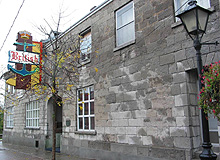
Yet another of Conroy’s properties was the British Hotel (71 Principale Street), an Aylmer landmark even today. The building, which dates to 1841, and which once competed with Symmes Inn as a stop on the stage and steamer route up the Ottawa River, has seen only minor alteration to its façade. It operates as a pub to this date.
References:
City of Aylmer / Aylmer Heritage Association, Walking Through Aylmer / Découvrir Aylmer à pied, 1992.
Diane Aldred / Aylmer Heritage Association, Aylmer, Québec: Its Heritage / Son Patrimoine, 1989.
CLICK HERE FOR Historic Aylmer, Part 2:
http://outaouais.quebecheritageweb.com/attraction/historic-aylmer-part-2